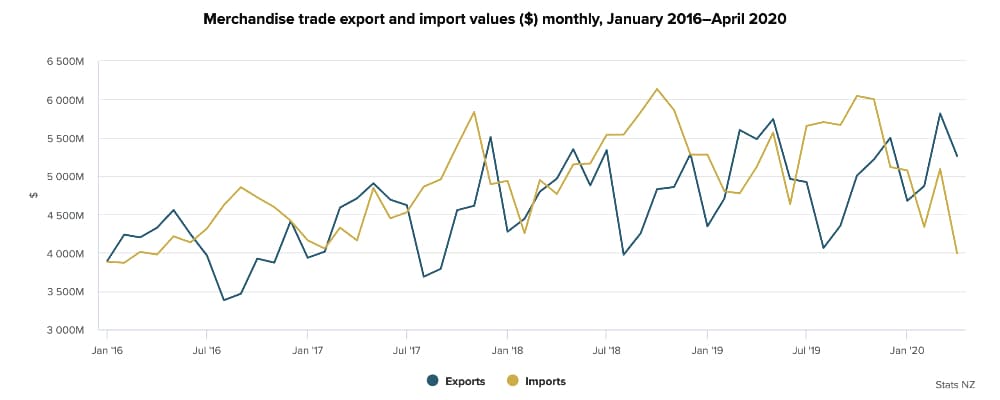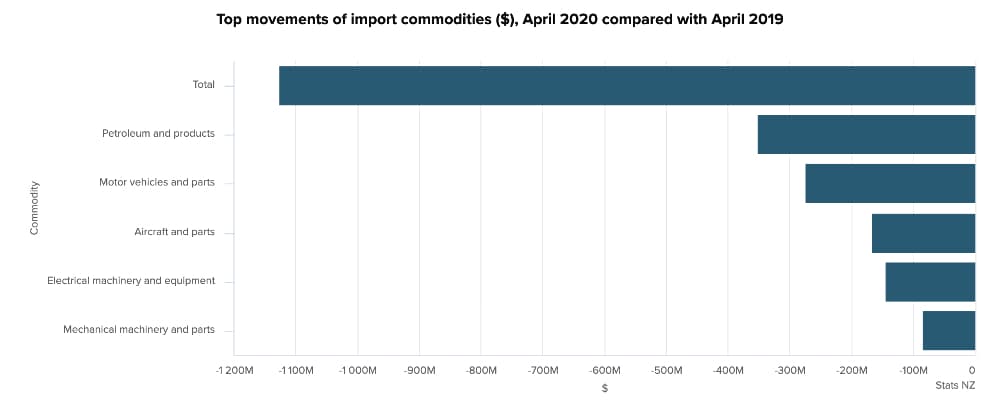
Imports in April 2020 Had the Biggest Fall Since 2009
3-minute read
Imports in April 2020 had their biggest fall since October 2009, resulting in a monthly trade surplus of $1.3 billion, Stats NZ said today.
“This is the largest monthly trade surplus on record and the annual goods trade deficit is the lowest since March 2015,” international statistics manager Darren Allan said.
“A sharp fall in imports of petroleum, vehicles, and machinery, combined with steady exports, led to a record trade surplus.”
The value of goods imported in April 2020 fell $1.1 billion (22 percent) to $4.0 billion when compared with April 2019. This is the second largest fall on record since the series began in 1960.
This drop coincides with the COVID-19 level 4 lockdown, which started at the end of March and ran until the end of April, when non-essential businesses temporarily closed.

The largest contributor to the fall in imports was petroleum and products, which fell $352 million (58 percent) from a year ago. Within this category the value of crude oil imports fell $255 million (77 percent) after a relatively high value in April last year.
“This is crude oil’s lowest value since May 2018,” Mr Allan said.
“May 2018 was when the Marsden Point refinery closed for maintenance.”
A fall in petrol and diesel of $97 million (down 35 percent) coincided with fewer New Zealanders driving their cars during the alert level 4 lockdown. Households are the largest users of petrol in New Zealand (using 59 percent of total petrol in the year ended March 2013).

“Imports of cars and trucks also dropped as COVID-19 disrupted both the international supply chain and the local demand for new vehicles, with car dealerships closed during the lockdown,” Mr Allan said.
This resulted in a fall of $119 million (33 percent) in car imports and a $111 million (52 percent) drop in imports of trucks and vans. The fall in motor cars was also reflected in the number of newly registered cars plunging from 17,661 to 1,329.
Imports of cell phones also fell sharply in April 2020, down $36 million (42 percent). This was the largest contributor to the fall in electrical machinery and equipment, down $144 million (32 percent).
Imports of face masks and laptops jump in April
New Zealand imported $65 million worth of face masks in April 2020, during the alert level 4 lockdown imposed by the government to stop the spread of COVID-19.
“This is the single biggest month for imports of face masks on record and up $58 million on levels seen in the same month in 2019,” Mr Allan said.
“This follows an announcement from the government that they had managed to arrange the import of 41 million masks from China.”
Imports from China of laptop computers also rose $43 million (62 percent), coinciding with many New Zealanders working from home because non-essential businesses were closed.
Imports from European Union drop
Imports from the European Union (EU) fell in April 2020 when compared with April 2019, down $405 million (40 percent), from $1 billion to $606 million. A large portion ($166 million) of this fall was due to a high value of aircraft and parts imported in April last year.
Imports of aircraft and parts typically move up and down sharply, due to the timing of large aircraft arrivals.

Imports from the EU of electrical machinery and equipment, rail locomotives and rolling stock, and mechanical machinery, also fell compared with April 2019.
Export values came in at $5.26bn (down 4% y/y) with strong lifts in dairy and fruit exports. Fruit exports were up 31% m/m while exports of dairy commodities rose 22% and infant formula was up 33%.
Forestry exports in April were restricted by this sector being unable to operate under Level 4 lockdown conditions. Returns from the export of forestry products fell 69% m/m in April and are down 44% from February to April due to restricted export volumes and weak prices. This sector is now back operating at full capacity and prices have also improved so May data should paint a more optimistic picture.
Exports to Asia fell just 0.1% in April while exports to the EU were back 15%. Exports to Australia fell 24.1% while exports to the United States held steady. A sharp lift in exports to Japan (+27.1) more than offset a reduction in exports to South Korea (-24.2%).
On a seasonally adjusted basis exports fell 7% m/m in April while imports fell 22.9% as many products were not able to be imported under lockdown.
Imports of vehicles and oil fell sharply during April but all broad economic categories fell. Vehicle imports fell 38%, petrol was down 58% and electrical goods were down 32%. The health sector was one of the few categories where imports lifted with an 11% lift in imports of pharmaceutical products.
Imports from China were up in April (+7.8%) but imports from virtually everywhere else fell sharply. Imports from Australia were down 16.4%, US down 9.4% and Japan down 32.1% while imports from the EU fell 40.1% y/y in April.
Going forward, we expect imports will lift in May as the rebound from lockdown begins. But over the longer term imports are expected to be constrained by reduced consumer demand and business investment. Exports in May will be strong, but volumes will start their seasonal decline.
Source: STATS NZ and ANZ Bank
P.S. Easy Freight Ltd helps New Zealand importers & exporters to save money on international freight and reduce mistakes by guiding how to comply with Customs and biosecurity rules.
➔ Contact us now to learn how we can assist you.
